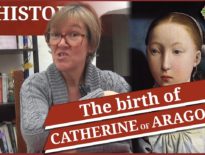On this day in Tudor history, 17th December 1538, Pope Paul III announced the excommunication of King Henry VIII.
Henry VIII had been threatened with excommunication several times, but his desecration of one of the holiest shrines in Europe was the final straw for the pope.
Find out how Henry VIII, who had once been "Defender of the Faith", had upset the Pope and what had been the final straw for the papacy in today's talk.
Also on this day in history:
- 1550 – Birth of Henry Cavendish, soldier, traveller and son of Bess of Hardwick and Sir William Cavendish. He was married to Grace Talbot, daughter of George Talbot, 6th Earl of Shrewsbury. This match was arranged by his mother who had married the Earl of Shrewsbury.
- 1559 – Matthew Parker was consecrated as Elizabeth I's Archbishop of Canterbury. According to “The Correspondence of Matthew Parker”, Anne Boleyn charged him with the care of Elizabeth when she saw him in April 1536, "not six days before her apprehension". Historian Eric Ives writes that this was a request that Parker never forgot, and something which stayed with him for ever. Parker obviously came to be important to Elizabeth, because she made him her Archbishop of Canterbury in 1559. It was a post which Parker admitted to Lord Burghley, he would not have accepted if he “had not been so much bound to the mother”. Parker was Archbishop until his death in 1575.
Transcript:
On this day in Tudor history, 17th December 1538, Pope Paul III announced the excommunication of King Henry VIII.
“Bull against Hen. VIII., renewing the execution of the bull of 30 Aug. 1535, which had been suspended in hope of his amendment, as he has since gone to still further excesses, having dug up and burned the bones of St, Thomas of Canterbury and scattered the ashes to the winds, (after calling the saint to judgment, condemning him as contumacious, and proclaiming him a traitor), and spoiled his shrine. He has also spoiled St. Augustine’s monastery in the same city, driven out the monks and put in deer in their place.”
Henry VIII had already upset the Pope and the Catholic Church by:
• Annulling his marriage to Catherine of Aragon and marrying Anne Boleyn
• Declaring himself “Supreme Head of the Church of England
• Persecuting those who opposed the Acts of Supremacy and Succession
• Dissolving the monasteries
• and His handling of the Pilgrimage of Grace
And it wasn’t as if he hadn’t had any warnings. Pope Clement VII had threatened the king with excommunication in March 1530, after he had found out from Catherine of Aragon that Henry had boasted that he would take a second wife “notwithstanding the inhibition and mandate against him”.1 Then, in July 1533, the Pope had declared “his divorce from Katharine and marriage with Anne Boleyn null […] pronouncing the King to have incurred the greater excommunication, but suspending the declaration of the same till the end of September.” Henry VIII ignored the Pope’s warnings and on 30th August 1535 Pope Paul III issued a sentence of excommunication against the king. This excommunication was then suspended, in the hope that Henry would toe the line, but his subsequent behaviour led to the Pope finally renewing the bull and excommunicating the king on 17th December 1538.
The final straw, as mentioned in the bull of excommunication, was Henry’s attack on religious shrines in England, shrines that contained religious relics and that were visited by many pilgrims. One such shrine was that of St Thomas Becket (Thomas à Becket) in the Trinity Chapel of Canterbury Cathedral, which was seen as one of Europe’s holiest shrines and was therefore a popular destination for pilgrims from all over Europe. In a meeting of the King’s Council on the 24th April 1538 a “Process against St Thomas of Canterbury” was decided:
“Sentence to the effect that Thomas, formerly archbishop of Canterbury, having been cited, and no one having appeared for him, judgment is given that in his life time he disturbed the realm, and his crimes were the cause of his death, although the people hold him for a martyr. He is therefore never to be named martyr in future, his bones are to be token up and publicly burnt and the treasures of his shrine confiscated to the King. This edict to be published in London, Canterbury, and elsewhere. London, 11 June, 1538.
This sentence pronounced, the King commanded it to be put into execution 11 Aug. The gold and silver of the shrine (says Pollini) filled 26 waggons. On the 19th (St. Bernard’s duy), the sacrilege was completed and the sacred relics publicly burnt and the ashes scattered.”
One treasure which was purloined by the King from the shrine was the Regale of France, a great ruby which was donated by King Louis VII, and Henry VIII had this made into a thumb ring for himself.
Such desecration of a place which many pilgrims, and the Catholic Church as a whole, saw as holy, could not go unpunished and it was this final act which made Pope Paul III issue the Bull of Excommunication on this day in 1538. The pope had had enough of the English king.



What a terrible thing, the complete desecration of a holy shrine, the bones of Saint Thomas Becket, the murdered Archbishop of Canterbury, killed on the accidental orders of Henry ii, by four knights who more or less escaped punishment. Henry did public penance but his shrine was one of the holiest in England and Europe and one of the most important. Becket was made a Saint less than three years after his murder, at the alter of his own Cathedral, very fast for even those times and many miracles are reputedly happened there. Henry, himself had visited the shrine in happier times, but now he was a greedy old grump with delusions of grandeur who had defied Rome and persecuted even his friends. Under the guidance of Thomas Cromwell he had closed and defiled the monasteries. Now Henry Viii had gone too far.
The execution of two respected humanists like Thomas More and John Fisher, the execution of the holy monks, hung from their own walls, the break from Rome, his illegal annulment from Queen Katherine of Aragon, mistreatment of his daughter, Mary must have all lead to this moment. The Pope in my opinion was too patient with him, but then Henry had once defended the Holy Sea and that may have gained him a reprieve. But now he was blatantly destroying the Holy Shrines. He didn’t care. So now he was Excommunicated and the Kings of Europe were free to attack him, his people depose him and his life, throne and immortal soul hung in the balance. Henry was up a political creek without a paddle.